The Skylake Core i3 (51W) CPU Review: i3-6320, i3-6300 and i3-6100 Tested
by Ian Cutress on August 8, 2016 9:00 AM ESTConclusion
In this review we were able to source the three 6th Generation Intel Core i3 processors with a thermal design power of 51W. These three are the main focus of the 6th Gen Core i3 range, which also features lower power T/TE parts and a reduced graphics P SKU. The Core i3 line are characterized by their design: two cores with Hyperthreading, no Turbo boost, no overclocking, support of ECC and SGX/MPX, but no support for TSX. Prices for the Core i3 processors range from $117 to $149-$157, making them an interesting choice for ~$800 gaming PC builds.
| Intel's Skylake i3 LGA1151 CPUs | ||||||||
| C/T | L3 | Base | Turbo | HD | HD Turbo | TDP | MSRP | |
| Core i3-6320 | 2/4 | 4 MB | 3.9 | - | 530 | 1150 | 51W | $149 OEM $157 box |
| Core i3-6300 | 2/4 | 4 MB | 3.8 | - | 530 | 1150 | 51W | $138 OEM $147 box |
| Core i3-6100 | 2/4 | 3 MB | 3.7 | - | 530 | 1050 | 51W | $117 |
| Core i3-6300T | 2/4 | 4 MB | 3.3 | - | 530 | 950 | 35W | $138 |
| Core i3-6100T | 2/4 | 3 MB | 3.2 | - | 530 | 950 | 35W | $117 |
| Core i3-6100TE | 2/4 | 4 MB | 2.7 | - | 530 | 1000 | 35W | $117 |
| Core i3-6098P | 2/4 | 3 MB | 3.6 | - | 510 | 1050 | 54W | $117 |
This review tested the Core i3-6320, the i3-6300 and the i3-6100. All three differ in their base frequency in a regular fashion, going from 3.9 GHz to 3.8 GHz and 3.7 GHz respectively. The Core i3-6100 also has another two adjustments: the integrated graphics also comes down by 100 MHz, and it only has 3 MB of L3 cache rather than 4 MB like the other two. This cache deficit affects several benchmarks in our test, although it is workload dependent and most of the time acts similar to another 100 Mhz CPU frequency decline. But, at $19 less than the step up to the Core i3-6300, it sits higher on the price/performance ratio.
The main competition for these processors comes from three directions.
First, Intel is its own competition - while we typically talk about people upgrading from the previous generation to the new generation, the Core i3 isn't necessarily a part that has a similar refresh cycle, but Intel still has to convince users on the 2-5 year upgrade cycle that moving from i3 to i3 is a worthy pursuit.
The next two directions come from AMD, in the form of the FX CPUs and A10 APUs. The FX-6300 and FX-8300 families of CPUs are several years old in terms of microarchitecture, but offer six and eight threads respectively at nearly similar price points (the FX-6350 is more in line with the Core i3s than the FX-8350). On the APU side, the A10-7860K and A10-7890K are both in the right price range and come with AMD's upgraded CPU cooler, which we recently reviewed and gave an award as the best bundled stock CPU cooler on the market. The APUs, while fairly newer than the FX parts, are known for their strong integrated graphics performance that easily surpasses Intel's gaming performance at this price point. It is worth noting that the older Intel CPUs and the AMD competition both use the higher powered DDR3 memory interface, while the Skylake-based Core i3 CPUs in this review are on the newer DDR4.
From our results, we can track whether the Core i3 parts have the best price/performance:

In our web tests using Chrome, Intel CPUs seem to have a significant advantage here which might be a deal breaker for users who spend a lot of time online.
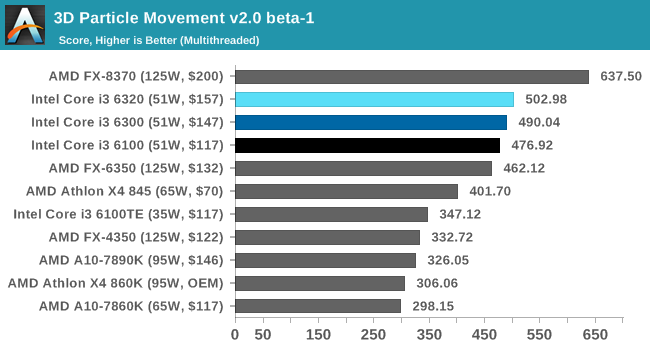
On our updated 3DPMv2 scientific benchmark, good cache management, a high IPC, and a high thread count is key to the results here. The Core i3 parts sit above the much older FX-6350 despite having two fewer threads, but AMD's latest microarchitecture in the Athlon X4 845 is close and gets a better price/performance rating.
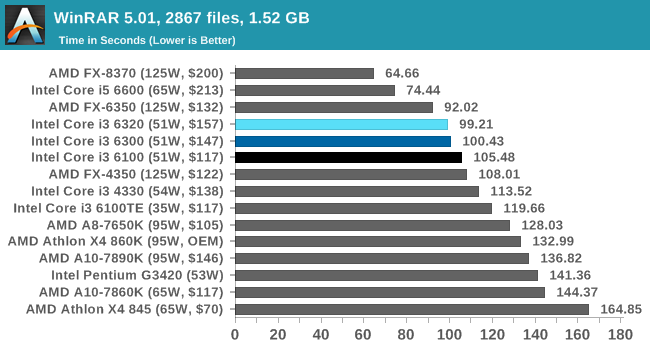
WinRAR is a variable threaded workload that requires large caches, high IPC and preferably a high frequency as well. The higher thread CPUs sit at the top here, followed closely by the set of Core i3 parts.
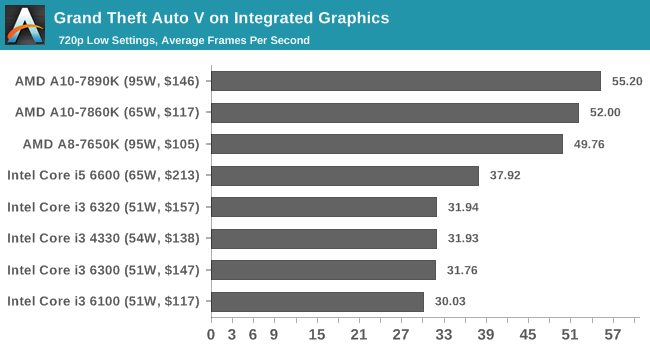
For integrated graphics, the Core i3 parts have no answer to what AMD offers at this price point. This is an important aspect, as Intel struggles to offer a part that can cope with year-old premium games at 30 FPS average at super low resolution and settings, let alone 30 FPS minimum (eSports may be a different story). The AMD parts are sole solution for premium gaming on integrated graphics at this price.
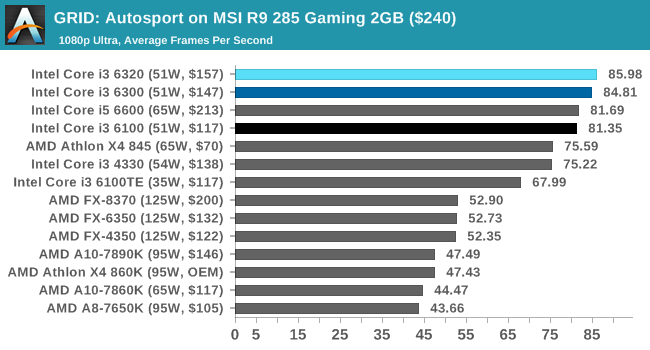
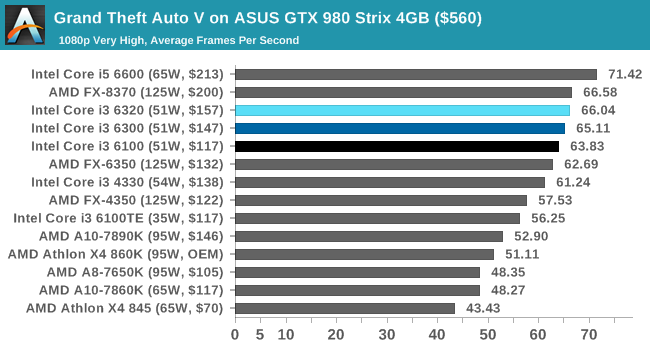
For discrete gaming, the results are particularly game and GPU dependent. In some cases, such as GRID with a mid-range AMD GPU, the Intel CPUs take the top spots with the latest Carrizo CPU from AMD coming up close behind. However, in other cases such as GTA on a high-end NVIDIA GPU, having more cache and physical cores in a modern game can push ahead of the Core i3, albeit at a higher price, and the Carrizo CPU comes in at the bottom due to its 2 MB of last-level cache.
Final Words
The Skylake Core i3 parts represent the best 'all-round' CPUs at their price. Choosing one for a system guarantees a good return in performance, and while it might not always be the best for specific applications, it's certainly near the top for almost everything. There were no circumstances where the Core i3-6100 is playing significant catchup to the other two, or that the lower cache was more of a hindrance. For ~$800 gaming builds that $30 difference between the i3-6100 and the i3-6320 could be spent elsewhere in the system. In our gaming tests the i3-6100 was only 2-4 FPS down (~5%).
Out of the three we've tested today, I would have to go for the Core i3-6100 as the processor of choice. For price and performance, the lower frequency and less cache only amounts to a 2-4% deficit at best compared to the next CPU up. The savings for 2-4% performance comes in at $30, or 20% cheaper, when we compare boxed versions.











94 Comments
View All Comments
fanofanand - Monday, August 8, 2016 - link
LOL nice. I believe Cellar Door was stating that bug77's comments were poorly educated. :PStas - Sunday, August 14, 2016 - link
Maybe he's just giving us some examples?bug77 - Tuesday, August 9, 2016 - link
Based on two assumptions (and nothing more), you know for certain my comment is poorly educated. Nice.Dritman - Thursday, August 18, 2016 - link
Explain to me then, the benefit of having a faster system if the speed boost is imperceptible to the user. You also have no insight into how the original commenter is using their system. Grow up.Voldenuit - Tuesday, August 9, 2016 - link
>Neah, I went i5-2500k -> i5-6600k and there's no noticeable difference.In gaming or general applications? If gaming, are you on a 60 Hz display? That could be the biggest bottleneck right there, assuming you have a modern GPU to go with that 6600K.
VeauX - Monday, August 8, 2016 - link
I have no compelling reason to retire my 2500K still. Running at 4.5GHz 24/7 for years, it is still able to swallow everything I throw at it without issues. The only thing would be the feature set of the new Chipsets (M2 etc...) but .... meh...kmmatney - Tuesday, August 9, 2016 - link
Last Xmas I bought my son a 2600K + motherboard for less than ~$200 on Ebay. It may be old, but still runs everything without a hitch, and having 8 threads is great when needed. Intel is competeing against itself, including what you can get used nowadays.eaglehide - Monday, August 8, 2016 - link
The graphs are not clickable on the GTA V page.sheh - Monday, August 8, 2016 - link
ECC only in low-end CPUs?!owan - Monday, August 8, 2016 - link
ECC is a Xeon feature once you moving up Intel's food chain. If you need 4+ cores and ECC, you need to get a Xeon